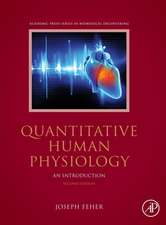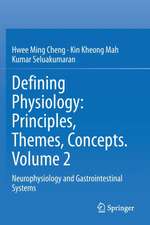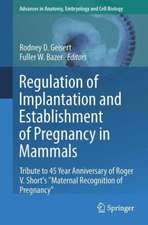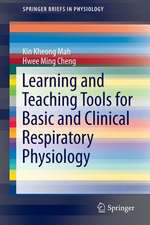Defining Physiology: Principles, Themes, Concepts: Cardiovascular, Respiratory and Renal Physiology
Autor Hwee Ming Cheng, Felicita Jusofen Limba Engleză Hardback – 11 iun 2018
| Toate formatele și edițiile | Preț | Express |
|---|---|---|
| Paperback (1) | 844.13 lei 38-44 zile | |
| Springer Nature Singapore – 22 dec 2018 | 844.13 lei 38-44 zile | |
| Hardback (1) | 908.27 lei 22-36 zile | |
| Springer Nature Singapore – 11 iun 2018 | 908.27 lei 22-36 zile |
Preț: 908.27 lei
Preț vechi: 956.08 lei
-5% Nou
Puncte Express: 1362
Preț estimativ în valută:
173.81€ • 180.37$ • 145.28£
173.81€ • 180.37$ • 145.28£
Carte disponibilă
Livrare economică 24 februarie-10 martie
Preluare comenzi: 021 569.72.76
Specificații
ISBN-13: 9789811304989
ISBN-10: 981130498X
Pagini: 215
Ilustrații: XIX, 187 p. 69 illus., 54 illus. in color.
Dimensiuni: 155 x 235 mm
Greutate: 0.5 kg
Ediția:1st ed. 2018
Editura: Springer Nature Singapore
Colecția Springer
Locul publicării:Singapore, Singapore
ISBN-10: 981130498X
Pagini: 215
Ilustrații: XIX, 187 p. 69 illus., 54 illus. in color.
Dimensiuni: 155 x 235 mm
Greutate: 0.5 kg
Ediția:1st ed. 2018
Editura: Springer Nature Singapore
Colecția Springer
Locul publicării:Singapore, Singapore
Cuprins
Cardiovascular System
A. Heart as an Electrical Organ
1. pacemaker potential, 2, ionic fluxes of action potential, 3. atrio-ventricular node, 4. prolonged depolarization, 5. myocardial calcium fluxes, 6.electrocardiogram, 7. P-R interval, 8. S-T segment, 9. cardiac vagal tone, 10. Hyperkalemic effects.
B. Heart as a Rhythmic Pump
1. stroke volume, 2. contractility, 3. cardiac output, 4. Starling’s cardiac mechanism, 5. Ejection fraction, 6. systole, 7. diastole, 8.cardiac cycle, 9. heart sounds, 10. iso-volumetric phase.
C. Heart as a Pressure Producer
1. arteriole, 2. venous capacitance, 3. venoconstriction, 4. aortic pressure, 5. arterial recoil, 6. Korotkoff sounds, 7. total peripheral resistance, 8. afterload, 9. preload, 10. central venous pressure.
D. Pathways from the Heart
1. capillary dynamics, 2. plasma oncotic pressure, 3. lymphatic drainage, 4. venous return, 5. mean systemic filling pressure, 6. pulmonary circulation, 7. Hemodynamics of flow, 8. Flow rate/velocity, 9. cardio-renal mechanisms, 10. Vascular congestion
E. Physiological Adaptations of the Cardiovascular system
1. effective circulatory volume, 2. trans-capillary shift, 3. venous pooling, , 4. baroreflex, 5. Bainbridge reflex, 6.autoregulation of blood flow, 7. hyperemia, 8. Arterial-venous O2 , 9. sympathetic vasoconstriction, 10. coronary circulation.
Respiratory Physiology
A. Mechanics of Respiration
1. Tidal volume, 2. intra-pleural pressure, 3. trans-mural pressure, 4. anatomical dead space, 5.alveolar ventilation 6. airway resistance, 7.functional residual capacity, 8. vital capacity, 9. alveolar surface tension, 10. lung elastic recoil
B. Alveolar-Capillary Exchange
1. Partial pressure, 2. pulmonary transit time, 3. perfusion -limited, 4.diffusion distance, 5. diffusion capacity of oxygen, 6.ventilation/perfusion matching, 7. hypoxic pulmonary vasoconstriction, 8. Physiologic/alveolar shunt, 9. pulmonary vascular recruitment and distention, 10. respiratory ‘pump’.
C. Oxygen Transport
1. Blood O2 content 2.hemoglobin-O2 saturation 3. hemoglobin-O2 affinity, 4. Bohr’s effect, 5.tissue O2 extraction, 6. oxygen delivery rate (ml/min), 7. stagnant hypoxia, 8. anemic hypoxia, 9. hyperventilation and PO2 10. secondary polycythemia.
D. Carbon Dioxide Transport
1. Blood CO2 content 2.Henry’s gas laws 3.plasma bicarbonate 4. carbonic anhydrase, 5.alveolar ventilation equation, 6. Alveolar/expired PCO2, 7. Haldane’s effect, 8.Hyperventilation and CO2, 9. CO2 physiologic functions, 10. CO2 and cerebral circulation.
E. Control of Respiration
1. chemoreceptors, 2. respiratory centers, 3. hypoxic drive, 4.hypoventilation, 5. hypercapnia, 6. exercise hyperpnea, 7.respiratory alkalosis 8.pH regulation, 9. cardio-respiratory functions, 10. high altitude acclimatization.
Renal Physiology
A. Glomerular Filtration and Renal Blood Flow
1. Renal arterioles, 2. glomerular Starling’s forces, 3. filtration coefficient, 4. Renal clearance, 5. freely filtered, 6. Filtered load, 7. Filtration fraction, 8. Creatinine clearance, 9. Tubulo-glomerular feedback, 10.renal autoregulation ‘masked’
B. Tubular Function
1. Iso-osmotic water reabsorption, 2. Renal plasma threshold, 3. Tubular transport maximum, 4. Glomerulo-tubular balance, 5. Tubular secretion, 6. Polyspecific organic transporters, 7. Peritubular capillary dynamics, 8. proximal urea transport, 9. Na/K/2Cl symporter, 10.Macula densa.
C. Sodium and Potassium Balance
1. Juxta-glomerular cells, 2. sodium/volume sensers, 3. natriuresis, 4.excreted sodium load, 5. renal perfusion pressure, 6.renin-angiotensin system, 7. renal sympathetic nerve, 8.aldosterone escape, 9. proximal potassium reabsorption, 10.transtubular potassium secretion.
D. Water Balance
1. Juxtamedullary nephrons 2. Counter current flow, 3. hyperosmotic interstitium, 4. differential permeability of Henle’s loop, 5. diluting segment, 6. Vasa recta, 7.urea recycling, 8. water diuresis, 9.osmotic diuresis, 10. Sodium concentration and osmoreceptors
E. Acid-base Balance
1. non-volatile acid, 2.bicarbonate proximal reabsorption, 3. luminal carbonic anhydrase, 4.tubular bicarbonate synthesis 5.urinary buffer, 6.net acid excretion, 7. Reno-respi pH regulation, 8. urinary ammonium, 9. ECF potassium effects, 10. pH and ECF calcium.
A. Heart as an Electrical Organ
1. pacemaker potential, 2, ionic fluxes of action potential, 3. atrio-ventricular node, 4. prolonged depolarization, 5. myocardial calcium fluxes, 6.electrocardiogram, 7. P-R interval, 8. S-T segment, 9. cardiac vagal tone, 10. Hyperkalemic effects.
B. Heart as a Rhythmic Pump
1. stroke volume, 2. contractility, 3. cardiac output, 4. Starling’s cardiac mechanism, 5. Ejection fraction, 6. systole, 7. diastole, 8.cardiac cycle, 9. heart sounds, 10. iso-volumetric phase.
C. Heart as a Pressure Producer
1. arteriole, 2. venous capacitance, 3. venoconstriction, 4. aortic pressure, 5. arterial recoil, 6. Korotkoff sounds, 7. total peripheral resistance, 8. afterload, 9. preload, 10. central venous pressure.
D. Pathways from the Heart
1. capillary dynamics, 2. plasma oncotic pressure, 3. lymphatic drainage, 4. venous return, 5. mean systemic filling pressure, 6. pulmonary circulation, 7. Hemodynamics of flow, 8. Flow rate/velocity, 9. cardio-renal mechanisms, 10. Vascular congestion
E. Physiological Adaptations of the Cardiovascular system
1. effective circulatory volume, 2. trans-capillary shift, 3. venous pooling, , 4. baroreflex, 5. Bainbridge reflex, 6.autoregulation of blood flow, 7. hyperemia, 8. Arterial-venous O2 , 9. sympathetic vasoconstriction, 10. coronary circulation.
Respiratory Physiology
A. Mechanics of Respiration
1. Tidal volume, 2. intra-pleural pressure, 3. trans-mural pressure, 4. anatomical dead space, 5.alveolar ventilation 6. airway resistance, 7.functional residual capacity, 8. vital capacity, 9. alveolar surface tension, 10. lung elastic recoil
B. Alveolar-Capillary Exchange
1. Partial pressure, 2. pulmonary transit time, 3. perfusion -limited, 4.diffusion distance, 5. diffusion capacity of oxygen, 6.ventilation/perfusion matching, 7. hypoxic pulmonary vasoconstriction, 8. Physiologic/alveolar shunt, 9. pulmonary vascular recruitment and distention, 10. respiratory ‘pump’.
C. Oxygen Transport
1. Blood O2 content 2.hemoglobin-O2 saturation 3. hemoglobin-O2 affinity, 4. Bohr’s effect, 5.tissue O2 extraction, 6. oxygen delivery rate (ml/min), 7. stagnant hypoxia, 8. anemic hypoxia, 9. hyperventilation and PO2 10. secondary polycythemia.
D. Carbon Dioxide Transport
1. Blood CO2 content 2.Henry’s gas laws 3.plasma bicarbonate 4. carbonic anhydrase, 5.alveolar ventilation equation, 6. Alveolar/expired PCO2, 7. Haldane’s effect, 8.Hyperventilation and CO2, 9. CO2 physiologic functions, 10. CO2 and cerebral circulation.
E. Control of Respiration
1. chemoreceptors, 2. respiratory centers, 3. hypoxic drive, 4.hypoventilation, 5. hypercapnia, 6. exercise hyperpnea, 7.respiratory alkalosis 8.pH regulation, 9. cardio-respiratory functions, 10. high altitude acclimatization.
Renal Physiology
A. Glomerular Filtration and Renal Blood Flow
1. Renal arterioles, 2. glomerular Starling’s forces, 3. filtration coefficient, 4. Renal clearance, 5. freely filtered, 6. Filtered load, 7. Filtration fraction, 8. Creatinine clearance, 9. Tubulo-glomerular feedback, 10.renal autoregulation ‘masked’
B. Tubular Function
1. Iso-osmotic water reabsorption, 2. Renal plasma threshold, 3. Tubular transport maximum, 4. Glomerulo-tubular balance, 5. Tubular secretion, 6. Polyspecific organic transporters, 7. Peritubular capillary dynamics, 8. proximal urea transport, 9. Na/K/2Cl symporter, 10.Macula densa.
C. Sodium and Potassium Balance
1. Juxta-glomerular cells, 2. sodium/volume sensers, 3. natriuresis, 4.excreted sodium load, 5. renal perfusion pressure, 6.renin-angiotensin system, 7. renal sympathetic nerve, 8.aldosterone escape, 9. proximal potassium reabsorption, 10.transtubular potassium secretion.
D. Water Balance
1. Juxtamedullary nephrons 2. Counter current flow, 3. hyperosmotic interstitium, 4. differential permeability of Henle’s loop, 5. diluting segment, 6. Vasa recta, 7.urea recycling, 8. water diuresis, 9.osmotic diuresis, 10. Sodium concentration and osmoreceptors
E. Acid-base Balance
1. non-volatile acid, 2.bicarbonate proximal reabsorption, 3. luminal carbonic anhydrase, 4.tubular bicarbonate synthesis 5.urinary buffer, 6.net acid excretion, 7. Reno-respi pH regulation, 8. urinary ammonium, 9. ECF potassium effects, 10. pH and ECF calcium.
Textul de pe ultima copertă
This first volume of the book covers 150 important words and phrases encountered in cardiovascular, respiratory and renal physiology, elaborating the concepts, principles and common themes around these words. It offers students a quiver of arrows to direct their thinking accurately in order to understand targeted processes in physiology. Physiology teachers also find this ‘definitive’ physiology text useful in their lectures and tutorial classes to elaborate on homeostatic mechanisms in physiology.
With any increase in physiological knowledge, there will be new words and terms that describe new mechanisms, and definitions of key words in core physiology are essential points of reference since they provide the foundational word pillars needed to understand physiology texts.
This book is a valuable companion to the Springer series “Physiology-Question Based Learning (Pq-BL)” by the author. Both the questions and words for learning physiology well have been selected from the successful annual Physiology Quiz International event that is chaired and designed by the author.
With any increase in physiological knowledge, there will be new words and terms that describe new mechanisms, and definitions of key words in core physiology are essential points of reference since they provide the foundational word pillars needed to understand physiology texts.
This book is a valuable companion to the Springer series “Physiology-Question Based Learning (Pq-BL)” by the author. Both the questions and words for learning physiology well have been selected from the successful annual Physiology Quiz International event that is chaired and designed by the author.
Caracteristici
Provides definitions of essential key words with conceptual elaborations
Offers figures to enhance each definition
Is a useful companion to the “Physiology-Question Based Learning” titles
Offers figures to enhance each definition
Is a useful companion to the “Physiology-Question Based Learning” titles

























